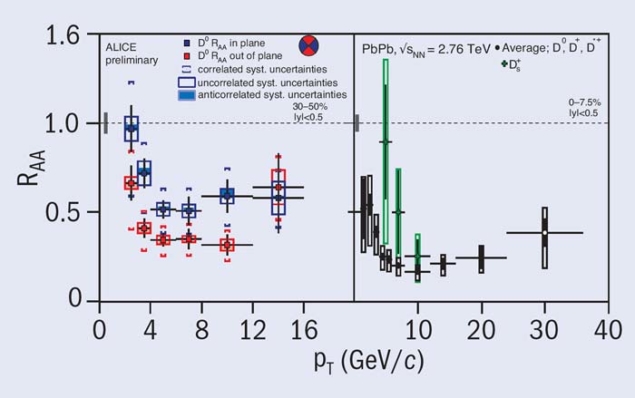
Using data from the second high-statistics lead–lead (PbPb) run of the LHC, which took place in 2011, the ALICE experiment is taking new directions in studying the interaction of charm quarks within strongly interacting matter at the high energy-density and temperature produced in these heavy-ion collisions. Following the observation of a large suppression of the production of charmed hadrons at high momentum (CERN Courier June 2012 p15), the collaboration is seeking further insight by quantifying the strength of this effect in different directions relative to the reaction plane, as well as by measuring the production of the charm-strange meson, Ds.

After production in initial hard partonic collisions, c and b quarks propagate across the expanding dense matter that has been formed in the PbPb collisions. Interactions with this medium’s constituents can lead to energy loss that results in the suppression of high-momentum hadrons, as observed for D mesons via the nuclear-modification factor RAA – the ratio of the yield measured in nucleus–nucleus collisions to that expected from a superposition of proton–proton collisions. It is an open question as to whether heavy quarks can be slowed down to the point of being affected by the collective expansion of the system or if they form hadrons by recombining with light quarks from the medium.
Because the overlap area of the two nuclei is almond-shaped, elongated in a direction perpendicular to the reaction plane (defined by the beamline and the impact parameter of the collision), non-central collisions exhibit an initial azimuthal anisotropy. ALICE measured RAA for charmed mesons by reconstructing secondary vertices from D0 → K–π+ decays in two 90°-wide regions of azimuthal angle centred on the in-plane and out-of-plane directions. As the left panel of the figure shows, the observed suppression is larger in the out-of-plane region than in the in-plane region. This suggests that charm quarks lose more energy when having a longer path length in the medium, in the out-of-plane direction. In the low-momentum range, collective expansion under anisotropic pressure gradients could also contribute to the observed azimuthal asymmetry (CERN Courier April 2011 p7).
By exploiting the high statistics available with the 2011 PbPb run, as well as the vertexing and hadron identification capabilities of the detector, the ALICE collaboration has for the first time been able to reconstruct Ds+ →K+K–π+ decays in heavy-ion collisions. Ds mesons are formed by a charm and a strange quark and are thus sensitive to the mechanism of c-quark hadronization – the process in which the quarks become bound in hadrons. In particular, if low-momentum c quarks hadronize by recombination, the Ds yield is expected to be enhanced with respect to that of non-strange D mesons, because of the high strangeness-content of the medium (CERN Courier December 2011 p20).
The right panel of the figure shows the values of RAA measured for Ds mesons in central collisions and reveals, at high momentum, an equally strong suppression as for non-strange D mesons. The suppression is reduced at lower momenta, although it remains consistent within uncertainties with that for non-strange D mesons. This is just a first measurement but it shows that with larger-statistics data samples from future LHC runs, ALICE should be able to draw firm conclusions on a possible enhancement of Ds production in PbPb collisions.








